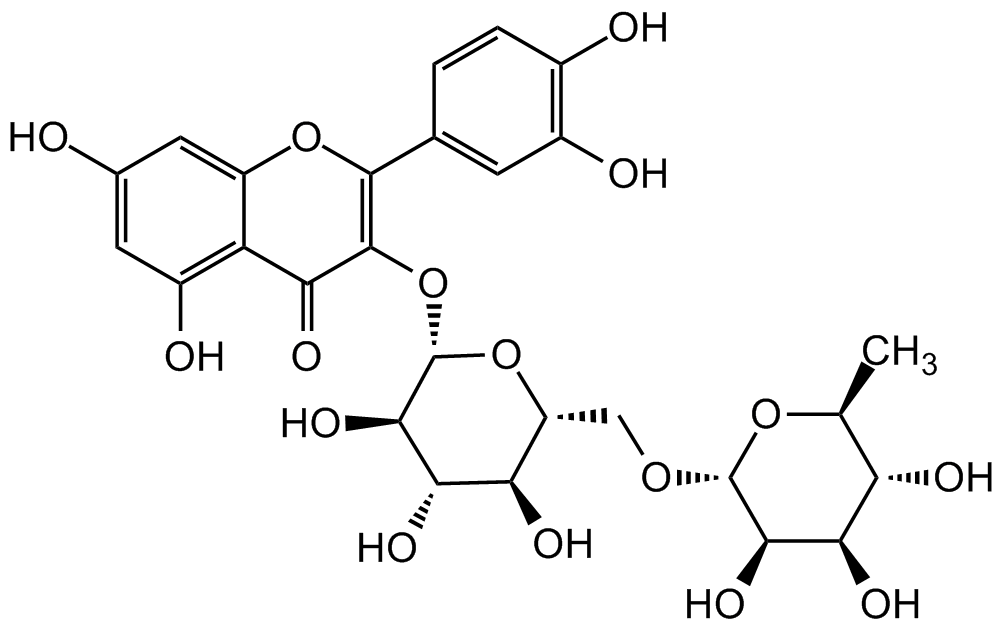Rutin
| Code | Size | Price |
|---|
| CDX-R0400-M050 | 50 mg | £108.00 |
Quantity:
Prices exclude any Taxes / VAT
Overview
Regulatory Status: RUO
Shipping:
AMBIENT
Storage:
Short Term Storage: +20?C. Long Term Storage: +20?C
Images
Documents
Further Information
Alternate Names/Synonyms:
Rutoside; Phytomelin; Sophorin; Birutan; Eldrin; Birutan Forte; Rutin trihydrate; Globularicitrin; Violaquercitrin; Quercetin rutinoside
Appearance:
Pale yellow powder.
CAS:
153-18-4
EClass:
32160000
Form (Short):
solid
GHS Symbol:
GHS07
Handling Advice:
Protect from light and moisture.
Hazards:
H302
InChi:
InChI=1S/C27H30O16/c1-8-17(32)20(35)22(37)26(40-8)39-7-15-18(33)21(36)23(38)27(42-15)43-25-19(34)16-13(31)5-10(28)6-14(16)41-24(25)9-2-3-11(29)12(30)4-9/h2-6,8,15,17-18,20-23,26-33,35-38H,7H2,1H3/t8-,15+,17-,18+,20+,21-,22+,23+,26+,27-/m0/s1
InChiKey:
IKGXIBQEEMLURG-NVPNHPEKSA-N
Long Description:
Chemical. CAS: 153-18-4. Formula: C27H30O16. Molecular Weight: 610.52. A polyphenolic flavonoid that acts as an antioxidant and NO scavenger. It can attenuate peroxide production in glial cells by acting as a free radical scavenger and protect renal cells from oxidative injury. Inclusion of rutin in the diet of rats significantly reduced the appearance of single-strand breaks in nuclear DNA caused by hepatocarcinogens aflatoxin B1 and N-nitrosodiumethylamine. This protection from DNA damage was found to be due to a reduction in the induction of repair enzymes polymerase, DNA polymerase beta and DNA ligase. Since DNA damage and inefficient repair are thought to initiate the process of carcinogenesis, effects of rutin on these functions suggests a protective role of this flavonoid against carcinogenesis induced by chemical carcinogens. Rutin ameliorates obesity through brown fat activation.
MDL:
MFCD00006830
Molecular Formula:
C27H30O16
Molecular Weight:
610.52
Package Type:
Vial
Precautions:
P264, P270, P301, P312, P330, P501
Product Description:
A polyphenolic flavonoid that acts as an antioxidant and NO scavenger. It can attenuate peroxide production in glial cells by acting as a free radical scavenger and protect renal cells from oxidative injury. Inclusion of rutin in the diet of rats significantly reduced the appearance of single-strand breaks in nuclear DNA caused by hepatocarcinogens aflatoxin B1 and N-nitrosodiumethylamine. This protection from DNA damage was found to be due to a reduction in the induction of repair enzymes polymerase, DNA polymerase beta and DNA ligase. Since DNA damage and inefficient repair are thought to initiate the process of carcinogenesis, effects of rutin on these functions suggests a protective role of this flavonoid against carcinogenesis induced by chemical carcinogens. Rutin ameliorates obesity through brown fat activation.
Purity:
>95% (HPLC)
Signal Word:
Warning
SMILES:
O=C1C2=C(O)C=C(O)C=C2OC(C3=CC(O)=C(O)C=C3)=C1O[C@H]4[C@H](O)[C@@H](O)[C@H](O)[C@@H](CO[C@H]5[C@H](O)[C@H](O)[C@@H](O)[C@H](C)O5)O4
Solubility Chemicals:
Soluble in DMSO.
Transportation:
Non-hazardous
UNSPSC Category:
Biochemical Reagents
UNSPSC Number:
12352200
Use & Stability:
Stable for at least 2 years after receipt when stored at RT.
References
(1) I.B. Afanas'ev, et al.; Biochem. Pharmacol. 38, 1763 (1989) | (2) R.P. Webster, et al.; Cancer Lett. 109, 185 (1996) | (3) E.A. Ostrakhovitch & I.B. Afanas'ev; Biochem. Pharmacol. 62, 743 (2001) | (4) N. Kamalakkannan & P.S. Prince; Basic Clin. Pharmacol. Toxicol. 98, 97 (2006) | (5) J.P. Lin, et al.; Leuk. Res. 33, 823 (2009) | (6) R. Lapa Fda, et al.; J. Pharm. Pharmacol. 63, 875 (2011) | (7) S.W. Wang, et al.; Neurotoxicology 33, 482 (2012) | (8) X. Yuan, et al.; FASEB J. 31, 333 (2016)



